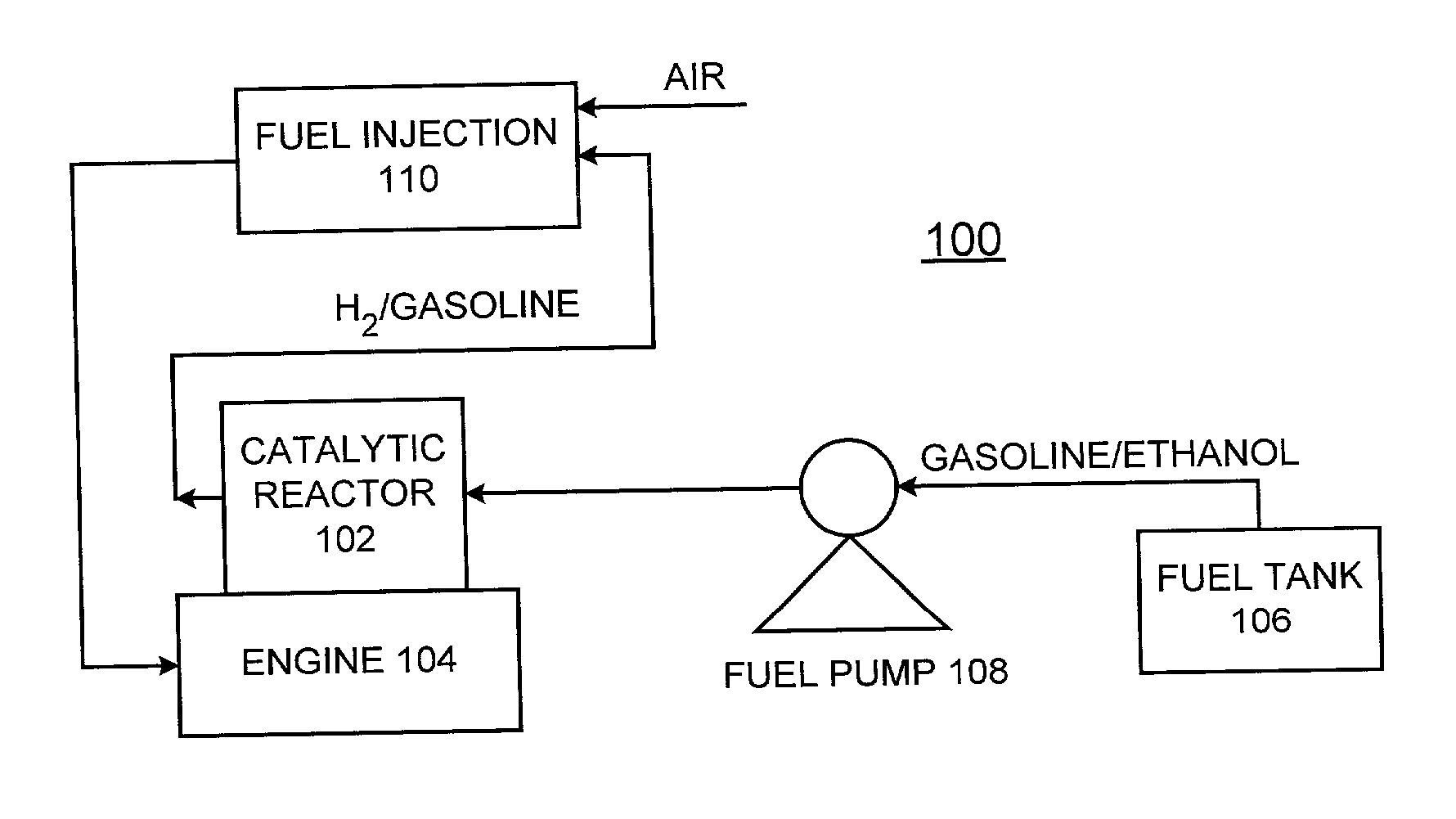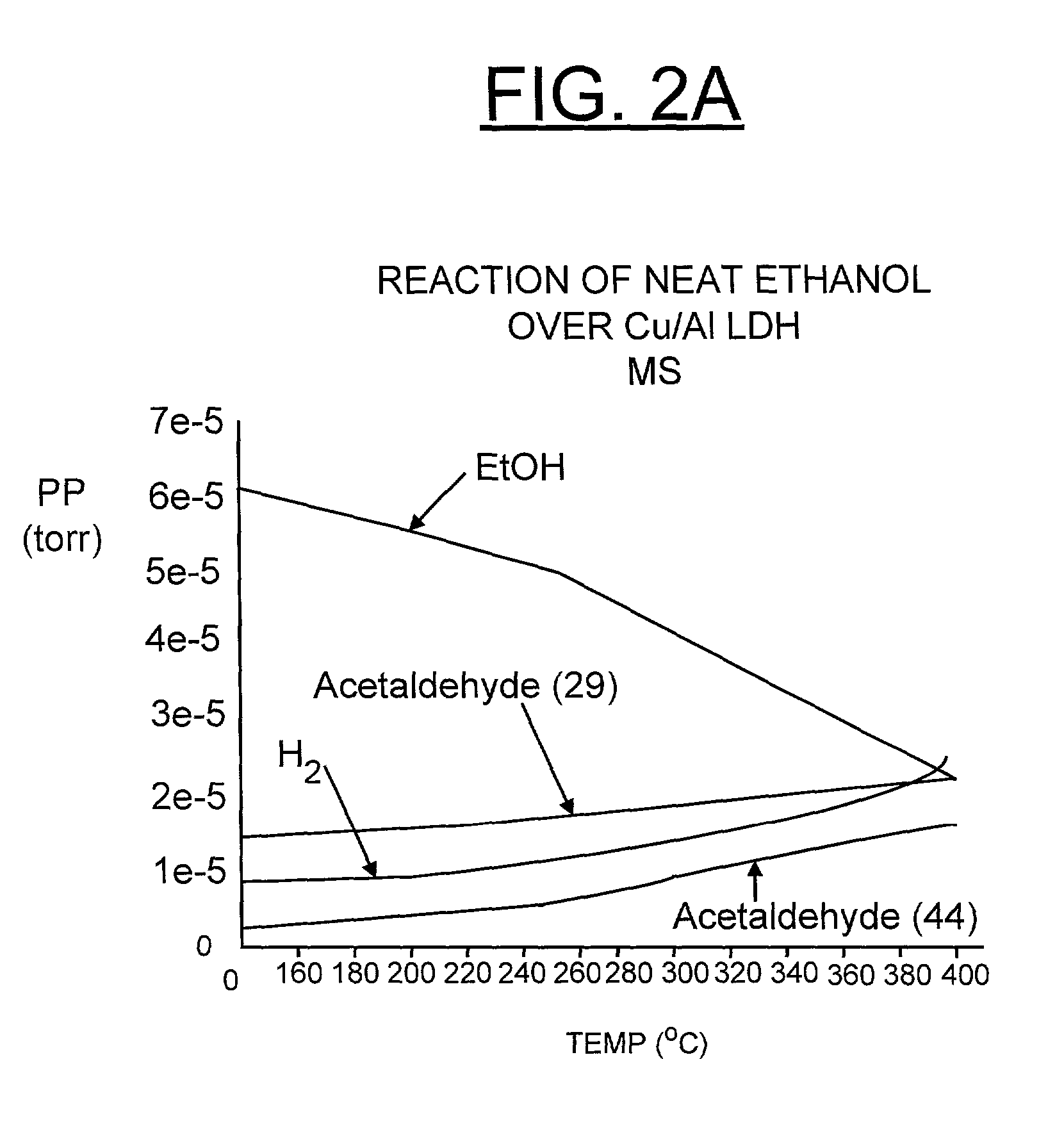Process for in-situ production of hydrogen (H2) by alcohol decomposition for emission reduction from internal combustion engines
a technology of alcohol decomposition and in-situ production of hydrogen, which is applied in the direction of combustion air/fuel air treatment, machines/engines, mechanical equipment, etc., can solve the problems of not being able to equip vehicles, not being able to maintain two discrete combustible fuels, and difficulty in providing a reliable hydrogen sour
- Summary
- Abstract
- Description
- Claims
- Application Information
AI Technical Summary
Problems solved by technology
Method used
Image
Examples
example 1
[0032] 1. Catalyst Preparation
[0033] The LDHs were prepared using a standard co-precipitation technique similar to that reported by Valente et al. The syntheses were performed at room temperature in air. The LDHs were synthesized by drop-wise addition of an aqueous solution containing 2M NaOH and 0.5M Na.sub.2CO.sub.3 to an aqueous M.sup.2+ / M.sup.3+ nitrate salt solution and vigorous stirring. The M.sup.2+ / M.sup.3+ ratio is 3 (M.sup.2+=0.75 M, M.sup.3+=0.25 M). The NaOH / Na.sub.2CO.sub.3 solution was added using a pH stat instrument (718 Stat Titrino, Metrohm), to maintain constant pH. All syntheses were done at pH=9.00.+-.0.02, except for the Cu / Al LDH (pH=8.00.+-.0.02). The M.sup.2+ / M.sup.3+ solution was added at a constant rate (0.4 ml / min) using a 776 Dosimat (Metrohm) instrument. After addition of all reagents, the solutions were heated overnight at 65.degree. C. with stirring. The samples were then filtered, washed several times with deionized water and dried in air at 80.degre...
example 2
[0034] Referring now to FIGS. 2A, 2B, 3A, 3B, 4, 5, 6, 7A and 7B, there are shown examples where H.sub.2 is generated by the catalytic reaction process of the invention. The illustrated reactions include neat ethanol, 10% ethanol / octane, 10% 1-propanol / octane, 10% 1-butanol / octane, and 10% methanol / toluene over Cu / Al LDH-derived catalyst.
[0035] FIGS. 2A and 2B generally illustrate the reaction of neat ethanol over Cu / Al layered double hydroxide (LDH)-derived catalyst in accordance with the preferred embodiment. The conditions are 0.150 g Cu / Al LDH, temperature (T) ramp of 2.degree. C. / minute, 100% ethanol, and liquid flow rate of 0.2 ml / min. In the absence of water, ethanol decomposes to H.sub.2 and acetaldehyde. This mechanism probably does not involve steam reforming. Hydrogen production is observed through 400.degree. C. Ethanol dehydrogenation is represented by:
CH.sub.3CH.sub.2OH.fwdarw.CH.sub.3CHO+H.sub.2
example 3
[0036] FIGS. 3A and 3B generally illustrate the reaction of 10% ethanol / octane over Cu / Al LDH-derived catalyst in accordance with the preferred embodiment. The conditions are 0.150 g Cu / Al LDH, temperature (T) ramp of 2.degree. C. / minute, and liquid flow rate of 0.2 ml / min. Hydrogen and acetaldehyde are produced at similar temperature and concentration as in the neat ethanol illustrated in FIGS. 2A and 2B. No significant octane decomposition results. It appears that H.sub.2 is formed from ethanol and that irreversible deactivation occurs at about 375.degree. C.
PUM
| Property | Measurement | Unit |
|---|---|---|
| temperatures | aaaaa | aaaaa |
| temperatures | aaaaa | aaaaa |
| temperatures | aaaaa | aaaaa |
Abstract
Description
Claims
Application Information
 Login to View More
Login to View More - R&D
- Intellectual Property
- Life Sciences
- Materials
- Tech Scout
- Unparalleled Data Quality
- Higher Quality Content
- 60% Fewer Hallucinations
Browse by: Latest US Patents, China's latest patents, Technical Efficacy Thesaurus, Application Domain, Technology Topic, Popular Technical Reports.
© 2025 PatSnap. All rights reserved.Legal|Privacy policy|Modern Slavery Act Transparency Statement|Sitemap|About US| Contact US: help@patsnap.com



